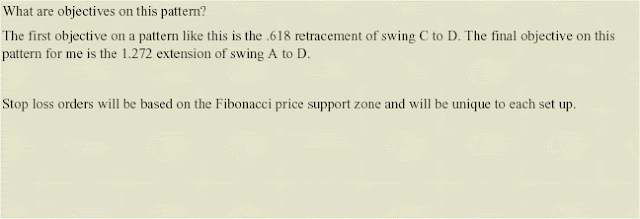Bearish Gartley
Bearish Gartley: A Recent Example
Bullish Gartley
A Recent Example of a Bullish Gartley Pattern
So why does this pattern work so well?
This is purely opinion, but as you look at the pattern construction there are two key elements to the success of this pattern.
Let’s put it in the context of a Bullish Gartley Pattern:
A) You are trading with the overall trend. Note that the move from X to A is a large move up, and that the move against the trend from A to D is counter to that of the XA move, but is contained within XA so the trend up is not broken. In fact, in Elliott Wave world the translation of this pattern is that we have one Impulse wave up from X to A, then three corrective moves to the downside (AB, BC, and CD). The conclusion then from Elliott Wave would be the likelihood for another impulse wave to the upside.
B) Secondly, the reason this pattern is successful is that it is a bit of a “trap.” Let’s look at this step by step from swing point A.
a. After establishing swing point A price drops down to B and forms a swing low. Psychologically traders see this as a defining point and start to accumulate positions on the long side.
b. As price climbs and forms a swing high C the positions are established and many stops are placed under the swing low B point. In fact, short sellers are even starting to look at this swing B point as a potential area to short if price comes back down.
c. As the pattern plays out and price starts coming down from swing high C, the longs are getting nervous and the shorts and sitting in the background ready to pounce. Then Whammo! Price goes below the swing low B and all of a sudden the weak long traders start selling and the short players begin to sell ‘em creating additional momentum to the downside that ultimately takes us down to ideally around the .786 retracement of swing XA. This is a defining point for the stock/commodity. This is where the Gartley pattern screams to look for opportunity to buy…why? Partly due to the fact that you are psychologically going against the market at this point.
d. If swing D holds above X and price starts to creep up traders get a little uptight. Then as price goes back above swing low point B the weak short players cover and the longs that got shook out come back in and you’re long position is enjoying the ride from this psychological shake out.
So, to conclude, the pattern has been successful for so many years, in my opinion because it trades WITH the trend (in the context of the XA move), AND it capitalizes on the psychological aspects of traders. This is a pattern that I think every trader should be aware of and in many cases should incorporate into their trading plan. Derrik Hobbs













No comments:
Post a Comment